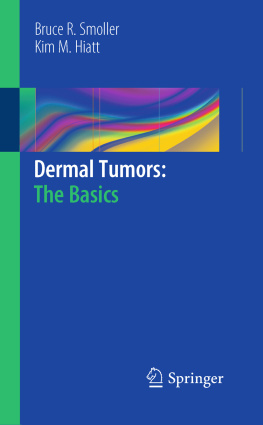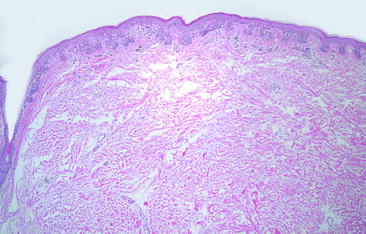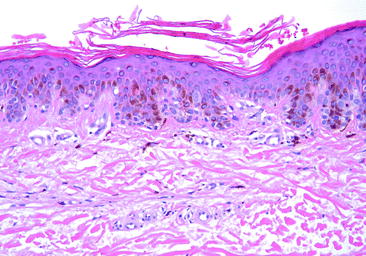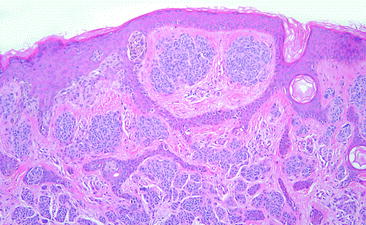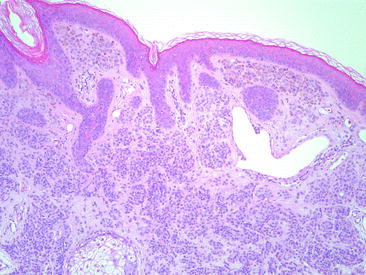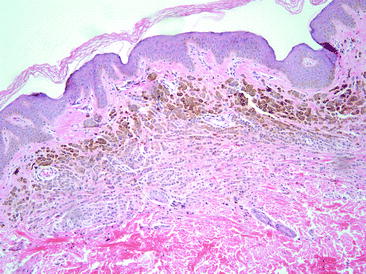Bruce R. Smoller and Kim M. Hiatt Epidermal Cell Tumors: The Basics 10.1007/978-1-4419-7704-5_1 Springer Science+Business Media, LLC 2011
1. Benign Melanocytic Proliferations
Bruce R. Smoller 1 and Kim M. Hiatt 1
(1)
Department of Pathology, University of Arkansas for Medical Sciences, Little Rock, AR 72205, USA
Abstract
Benign melanocytic proliferations
Also known as melanocytic nevi, moles
Nevus means hamartoma and is likely a misnomer and nevi have been shown to be true clonal proliferations
Present at birth, but most arise during adolescence or early adulthood
Only rarely arise later in life (after age 40)
Present in vast majority of Caucasians, also present in other racial groups
Benign melanocytic proliferations
Also known as melanocytic nevi, moles
Present at birth, but most arise during adolescence or early adulthood
Only rarely arise later in life (after age 40)
Present in vast majority of Caucasians, also present in other racial groups
Potential for malignant transformation is less than 1/100,000 in acquired melanocytic nevi
Benign melanocytic proliferations (see Table )
Table 1.1
Benign melanocytic proliferations
Common acquired melanocytic nevus |
Congenital melanocytic nevus |
Halo nevus |
Nevus of special sites (acral, genital) |
Combined nevus |
Balloon cell nevus | Volume III, |
Spindle and epithelioid cell (Spitz) nevus | Volume III, |
Blue nevus | Volume II, Chapter 12 |
Common melanocytic nevus
Proposed life cycle for melanocytic proliferations (including common acquired, congenital, dysplastic or atypical, Spitz, acral)
Clinical
Junctional nevus flat, deeply pigmented lesions with sharp edges, usually oval or circular
Compound nevus raised above surface of skin, retain pigmentation
Intradermal nevus nodular to polypoid, lose pigment (skin-colored)
Histologic
Junctional nevus proliferation of melanocytes confined to the epidermis, largely nested along basement membrane (Figs. )
Compound nevus some melanocytes drop into dermis and some remain in the epidermis (Fig. )
Intradermal nevus intraepidermal component of melanocytic proliferation is absent; all residual melanocytes are within dermis (Fig. )
Fig. 1.1
Junctional melanocytic nevus with nests of melanocytes confined to the base of rete ridges. Original magnification 40
Fig. 1.2
Junctional melanocytic nevus demonstrates small nests of melanocytes that can be differentiated from keratinocytes based upon morphologic features. Original magnification 200
Fig. 1.3
Compound melanocytic nevus has nests of nevus cells within the epidermis as well as within the dermis. Original magnification 100
Fig. 1.4
Intradermal nevus demonstrates nests of melanocytes restricted to the dermis with no epidermal involvement. Original magnification 100
Acquired melanocytic nevus
Histologic
Junctional component should be almost entirely nested and sharply circumscribed
Proliferation of single melanocytes is uncommon
Pagetoid cells may occur secondary to trauma, in childhood, and in acral sites, but should not be abundant
Pagetoid single or nested melanocytes located above the basal layer of the epidermis
Maturation in dermis (Fig. )
Dermal mitoses rare should never be at base of lesion
Fig. 1.5
Maturation is a feature of benign melanocytic proliferations. The melanocytes become smaller and darker and the nests become smaller and more widely dispersed with progressive descent into the dermis. Pigmentation also tends to diminish with progressive descent. Original magnification 100
Congenital melanocytic nevus
Clinical
Present in about 1% of newborns
Often larger than acquired nevi
May be hair-bearing
So-called giant congenital nevi (>20 cm) often have a bathing suit distribution
Incidence of developing melanoma
Histologic (Figs. )
Can be junctional, compound, or intradermal
Abundant single melanocytes within epidermis in some congenital nevi in children
Nevus nests extend into lower third of reticular dermis or into subcutis
Nevus nests track down appendages
Nevus nests often have a superficial perivascular dermatitis appearance at low magnification
Scattered Pagetoid cells may be present in the central portion of congenital nevi, especially during the first year of life
Pseudovascular spaces are often present and are due to dyscohesion of melanocytes within dermal nests (Fig. )
Neurotization is commonly seen and is believed to be part of the maturation process (Fig. )






